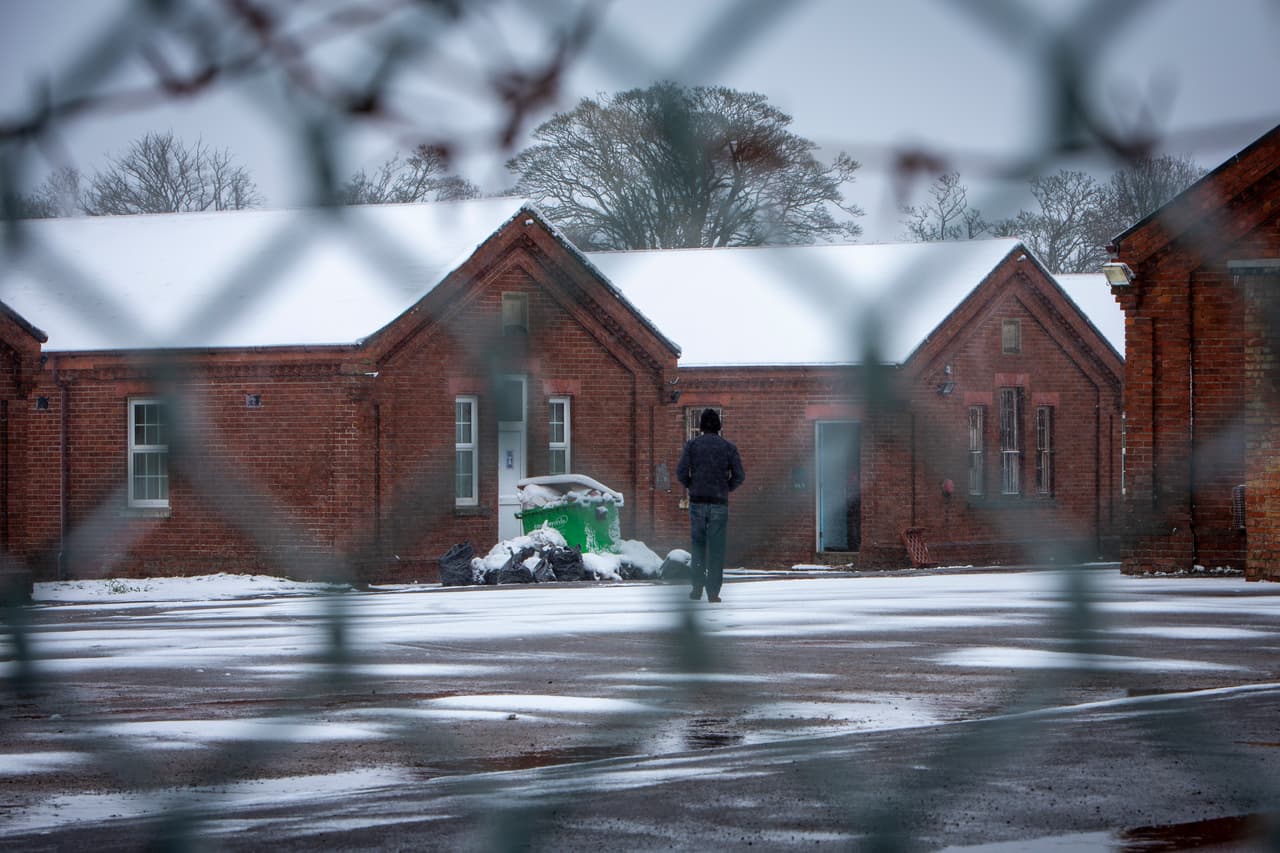
Revealed: Home Office knew housing refugees at run down barracks risked mass infection
The Home Office was aware of the health risks that came with housing asylum seekers at former military barracks where there has since been a major coronavirus outbreak, documents seen by the Bureau reveal.
Last year reports were compiled about Napier barracks in Kent and Penally camp in Pembrokeshire before asylum seekers were moved into both sites. The reports show that the Home Office knew the accommodation was in a “poor state of repair” and was explicitly warned that it would be a potential “risk” to house people in shared dormitories during a pandemic, but pushed forward with the plan regardless.
Since January, almost 200 people at Napier have tested positive for Covid-19.
The Home Office has repeatedly defended its decision to house hundreds of people in crowded accommodation, where up to 28 people have been sharing a dormitory block, since moving asylum seekers into the barracks in September.
In response to protests over the coronavirus outbreak and poor conditions at Napier camp – where a fire also broke out in January – the home secretary, Priti Patel, appeared to dismiss the concerns, saying that the site was used by “our brave soldiers and army personnel” and “it is an insult to say that it is not good enough for these individuals”.
 Priti Patel has defended the decision to use the two sites.
Matt Dunham/WPA Pool/Getty
Priti Patel has defended the decision to use the two sites.
Matt Dunham/WPA Pool/Getty
But the reports, which were accidentally released in full and seen by the Bureau, suggest otherwise. They describe Napier as being “slightly run down”, and paint an even worse picture of Penally, which is described as being in “poor” and “run down” condition, with “evidence of damp in some buildings”. They also make clear that the site’s Nissen huts, metal buildings which asylum seekers say some men were made to sleep in from October to the end of December, were not used by the military during the winter “due to the challenges heating them”.
“They will say that they didn’t use this kind of sleeping quarters,” one asylum seeker and former resident of Penally told the Bureau, speaking on the condition of anonymity. Sharing photos of the conditions inside the huts, they claimed: “This is just to prove that they did.”
Stuart McDonald MP, who sits on the home affairs select committee and questioned Patel on the issue at a hearing last week, told the Bureau it was “infuriating” and “disgraceful” that the home secretary had appeared to use “military personnel as a way to hide from accountability for the way she’s treating vulnerable people. [It appears] these barracks weren’t suitable for military personnel either.”
McDonald called for full transparency regarding the advice received by the Home Office about the two sites. “It seems increasingly like the Home Office has been reckless in regards to the safety and wellbeing of asylum seekers,” he said.
Our investigations get to the truth
Find out what they're hiding from you – sign up to our newsletter
Click here to get updatesDuring the committee hearing, a Home Office official confirmed that at least 197 people at the Napier site had tested positive for coronavirus in January and February. But despite nearly 400 people having been forced to share dormitories – including with people who had tested positive, according to residents – Patel denied her department was at fault for the outbreak, instead blaming asylum seekers who she said were “mingling” and “not following the rules”.
Patel also denied that her department had acted in defiance of guidance from Public Health England, despite submissions in a high court hearing last month showing that PHE had, in advice separate to the reports given to the Home Office, deemed the accommodations unsuitable.
Yvette Cooper MP, who chairs the home affairs select committee and has reviewed the documents seen by the Bureau, said: “Despite the Home Office’s insistence that sleeping arrangements in these barracks were Covid compliant, these documents make clear that they understood the risks with placing people in dormitory accommodation during a pandemic.”
The Home Office’s site visit reports – which were released after a Freedom of Information request was submitted online – were partially redacted. But due to an error in the redaction process, the Bureau was able to view them in their entirety. While an unredacted passage of the Napier report mentions that the dormitories had been made “Covid compliant” through the use of “socially-distanced beds”, the Home Office redacted the part explicitly stating that dormitory accommodation was a “risk”.
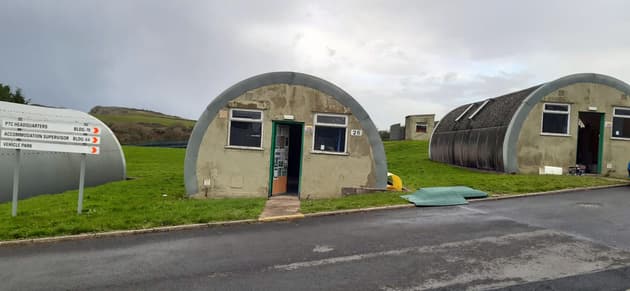 Nissen huts at Penally, which the report said were not used by soldiers in winter because of difficulties heating them
Nissen huts at Penally, which the report said were not used by soldiers in winter because of difficulties heating them
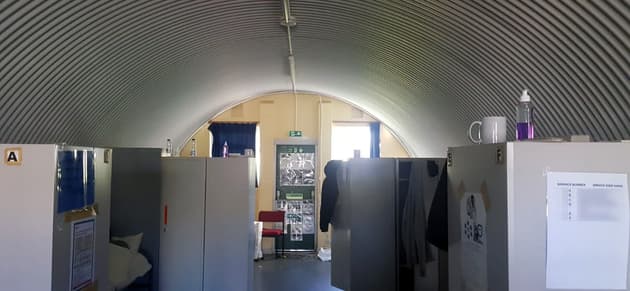 However, asylum seekers housed at the site by the Home Office said they slept in the huts until the end of December
However, asylum seekers housed at the site by the Home Office said they slept in the huts until the end of December
The report stated that Napier can house 523 people “at full normal capacity” but could only accommodate “431 under Covid-compliant social distancing requirements”.
On the face of it, the Home Office appears to have followed that strategy, initially housing about 400 men at the camp before moving hundreds of people out of the facility in the weeks following the January outbreak.
However, the document also warned that the accommodations would include “shared dormitories” and suggests that the “Covid-compliant” capacity for the site would be “dependent on [a] decision regarding [the] need for single bedrooms”. If the Home Office was required to convert dormitories into single-occupancy rooms, the report states, then the site’s capacity would lessen and would not be “viable”.
It appears the Home Office pushed ahead with plans to house most residents in shared rooms. Asylum seekers who were at Napier at the time of the outbreak told the Bureau that their experience was that only a handful of “single rooms” were made available, forcing people without symptoms to share dormitories with those who had tested positive, as well as with others who were showing symptoms.
The Home Office told the Bureau: “The Home Office and its providers have carried out necessary maintenance works and rigorous safety checks before bringing asylum seekers onto the site and complied with guidance from Public Health England throughout.”
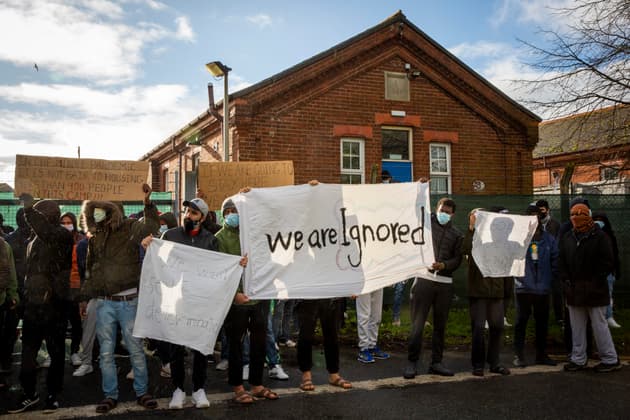 Residents at Napier protest their conditions
Andrew Aitchison/In Pictures/Getty
Residents at Napier protest their conditions
Andrew Aitchison/In Pictures/Getty
One man who wished to remain anonymous told the Bureau that even after nearly “half of the population there tested positive, including me, and we were still sharing our bedroom area”.
He said that when residents tried to flag their concerns to the camp supervisors employed by Clearsprings Ready Homes – the company contracted to oversee the Napier and Penally sites – they were simply told to “wear masks” and “use hand sanitisers”. Clearsprings declined to comment.
“The thing is, we cannot wear masks 24/7, [like] when you want to sleep and shower,” the former resident said. “I mean, I personally tried to […] keep myself distanced from other people, but the thing is that I was sharing my bedroom with 13 other people […] There was no distance. We were literally breathing in the same room.”
At Penally, there are even fewer options for someone with a potential case of coronavirus. “There is just one room to quarantine people,” said an asylum seeker who has been living there for nearly half a year. “All of the Penally camp is one bubble. It's zero safety against Covid.”
In a letter given to Penally residents on 18 February, the Home Office appeared to directly engage with this unease. Outlining a concern, stating "You are putting me at risk of getting Covid-19 by forcing me to live in a dormitory", the letter responded by saying that "all sites are following public health guidance” and that the government is "working with health officials to ensure we mitigate risks”.
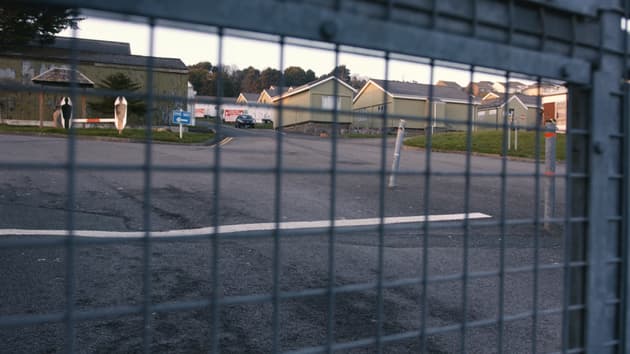 Barracks at the Penally site
Channel 4 News
Barracks at the Penally site
Channel 4 News
Josie Naughton, the co-founder of the refugees’ charity Choose Love, told the Bureau: “It’s shocking that it’s not just a mistake that wasn’t thought through.” There was a difference, she said, between “not realising that somewhere is going to be cold or that somewhere is going to be a public health risk, and realising it and doing it anyway”.
The reports also warned that the “austere” appearance of the Napier facility, which it was noted is “surrounded by an 8ft high fence with barbed wire”, could create a negative perception. The report continued: “The narrative is crucial to state it is there to keep [asylum seekers] safe and keep potential intruders out.”
They also warned of a “strong right wing presence” in Folkestone and that the “close proximity to small boat arrivals” on the British coast “raises sensitivities”. It is unclear whether the report suggests this represented a safety concern. What is clear, however, is that the potential health risks were well documented.
For the asylum seeker who tried to flag his concerns about the conditions at Napier, it comes as little surprise. “All of us had the fear that [a major outbreak] was going to happen sooner or later,” he said. “We all knew that this was not right.”
The Home Office said: “The government is meeting its statutory obligation to provide asylum seekers who would otherwise be destitute with accommodation. These sites are safe, secure and have accommodated soldiers and army personnel in the past – it is wrong to say that it is not good enough for asylum claimants.”
Reporters: Chantal Da Silva and Ben Stockton
Desk editor: James Ball
Investigations editor: Meirion Jones
Production editor: Alex Hess
Fact checker: Rosa Furneaux
Legal team: Stephen Shotnes (Simons Muirhead Burton)
Header image: Napier barracks photographed in February this year. Credit: Andrew Aitchison/In pictures via Getty Image
This report was supported by core Bureau funds. None of our funders have any influence over the Bureau’s editorial decisions or output.
-
Area:
-
Subject:





